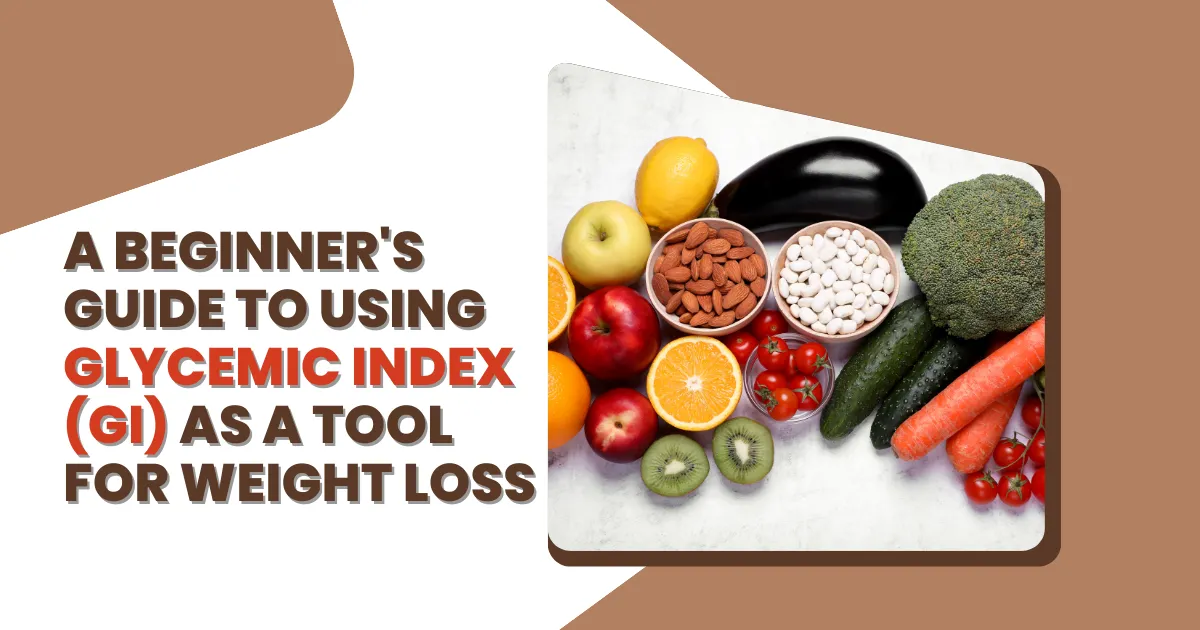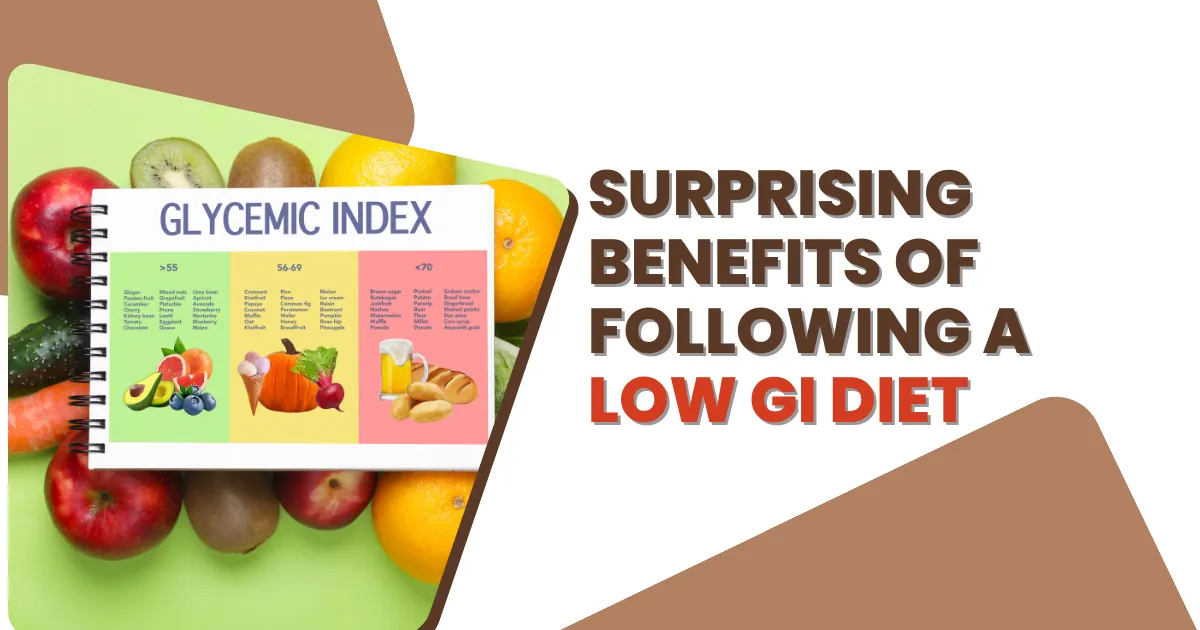Last updated on October 10th, 2025 at 03:53 pm
The Glycemic Index (GI) indicates how quickly a carbohydrate-containing food raises blood sugar levels. Keep in mind that GI values can vary based on factors such as cooking time and processing methods. This index ranks foods on a scale from 0 to 100 based on how much they affect blood sugar levels compared to a reference food, usually glucose or white bread.
The Significance of Glycemic Index (GI)
Why is GI Important?
Blood Sugar Management: GI is essential for individuals who need to manage their blood sugar levels, such as people with diabetes. Foods with a high GI value cause rapid spikes in blood sugar, leading to energy crashes and, over time, potentially contributing to insulin resistance and other health issues.
Energy and Satiety: Foods with a low GI value release glucose gradually into the bloodstream, providing sustained energy and helping to keep you feeling full for longer. This can be beneficial for weight management and overall energy levels.
Athletic Performance: Athletes can use the concept of GI to optimize their energy levels during training and competitions. Consuming foods with moderate GI values before exercise can provide a steady energy supply.
Heart Health: A diet based on low-GI foods has been associated with a reduced risk of heart disease. High-GI foods have been linked to inflammation and other risk factors for cardiovascular issues.
Food Choices: GI values can guide food choices, helping individuals select healthier carbohydrates and make more informed dietary decisions. Whole grains, legumes, and certain fruits and vegetables generally have lower GI values.
Balanced Diet: It’s important to remember that GI is just one aspect of a healthy diet. A balanced diet should include a variety of foods, including lean proteins, healthy fats, and fiber-rich options.
Personalized Nutrition: While GI is a helpful tool, individual responses to foods can vary. Factors such as meal composition, portion size, and food combinations also affect how foods impact blood sugar levels.
In conclusion, understanding the Glycemic Index can empower us to make smarter food choices. It’s especially beneficial for those managing diabetes or seeking sustained energy levels.
Glycemic Index and Load Calculator 🍎🍝
While GI measures how quickly a food causes blood sugar levels to rise, Glycemic Load considers the carbohydrate content in a serving to give a more accurate picture of a food’s real-life impact on blood sugar. A GL calculator can help individuals understand how much a particular food will affect their blood sugar levels.
10 Low Glycemic Index Foods That Will Help You Maintain Stable Blood Sugar Levels
1. Quinoa is a nutrient-rich grain with a low glycemic index (GI) score. It is high in fiber and protein, which helps slow down the digestion and absorption of carbohydrates, resulting in a more stable blood sugar level. The glycemic index (GI) of quinoa equals 35, which classifies it as a low-GI food
2. Sweet potatoes are a delicious and nutritious low-GI food option. They are rich in fiber and complex carbohydrates, which are digested more slowly, preventing spikes in blood sugar levels.
- Sweet potatoes are low glycemic when boiled and high glycemic when cooked any other way. Boiled sweet potatoes are roughly 46 on the glycemic index scale (low), and approximately 81 when cooked differently (high)
3. Legumes, such as lentils, chickpeas, and black beans, are excellent sources of protein and fiber. They have a low GI score and provide a steady release of energy, helping to maintain stable blood sugar levels.
- Chickpeas’ glycemic index (GI) is equal to 10, classifying it as a low-GI food. Chickpeas’ glycemic load (GL) equals 6.1, classifying it as a low GL food. 100 grams of chickpeas contain 364 kcal
4. Steel-cut oats are minimally processed and have a lower GI score than instant oats. They are high in fiber and provide sustained energy, making them an excellent choice for breakfast to start your day off on the right foot.
5. Greek yogurt is high in protein and low in carbohydrates, making it suitable for those looking to maintain stable blood sugar levels. It also contains beneficial probiotics that support gut health.
- Greek Yoghurt has a Glycemic Index of 11, which is low.
6. Nuts such as almonds, walnuts, and pistachios are nutritious snacks with a low GI score. They are packed with healthy fats, protein, and fiber, which contribute to slower digestion and help regulate blood sugar levels.
- Most nuts do not have a glycaemic index (GI). The exceptions are chestnuts (GI = 54), pistachios (GI = 28), cashews (GI = 25) and peanuts (GI = 13)
7. Berries, including strawberries, blueberries, and raspberries, are low in sugar and fiber. They have a low GI score and provide antioxidants that support overall health.
8. Leafy greens, such as spinach, kale, and Swiss chard, are low in calories and have a minimal impact on blood sugar levels. They are fiber-rich and contain essential nutrients like vitamins A and C.
9. Avocado is a nutrient-dense fruit that is low in carbohydrates and high in healthy fats. It has a low GI score and provides a slow release of energy, helping to maintain stable blood sugar levels.
- The avocado’s glycemic index (GI) equals 10, classifying it as a low-GI food.
10. Whole grain bread: Eating whole grains instead of white bread can help regulate blood sugar levels. Whole-grain bread is fiber-rich and contains complex carbohydrates, which are digested more slowly than refined grains.
Incorporating these low-GI foods into your diet can help maintain stable blood sugar levels and support overall health.
Q&A - High Glycemic Index Food
High glycemic index foods are those that are quickly digested and absorbed, leading to a rapid spike in blood sugar levels. These foods have a GI score of 70 or above on the GI scale, which ranges from 0 to 100.
People with diabetes need to be cautious about consuming high-GI foods because these rapid spikes in blood sugar can be difficult to manage and may lead to complications over time, including increased risk for cardiovascular disease, kidney damage, and vision problems.
Certainly! Some commonly consumed high-GI foods include:
- White bread: A high-GI option that can be replaced with whole grain or sourdough bread, which have lower GI values.
- Instant oatmeal: Instead, opt for steel-cut oats or old-fashioned rolled oats, which have a lower GI and provide a more stable energy release.
- White rice: A better alternative would be brown rice, quinoa, or bulgur, which are whole grains with lower GI scores.
- Potatoes: Sweet potatoes or yams are preferable options; however, the cooking method can also affect the GI, so baking or boiling is better than frying.
These alternatives not only have a lower glycemic index but also provide additional nutrients like fiber, vitamins, and minerals, which are beneficial for overall health.
Consuming high-GI foods leads to rapid increases in blood glucose levels. For individuals with diabetes, whose bodies struggle with insulin production or use, these spikes can be particularly challenging to manage.
Over time, frequent blood sugar spikes can contribute to the worsening of diabetes control, leading to a higher risk of diabetes-related complications such as nerve damage, heart disease, and retinopathy.
Moreover, high blood sugar levels can cause symptoms like increased thirst, fatigue, and difficulty concentrating, impacting overall quality of life.
Yes, there are specific circumstances where consuming high-GI foods might be beneficial for individuals with diabetes.
One common situation is during or after intense physical activity when the body needs quick energy replenishment.
Another scenario is treating hypoglycemia (low blood sugar), where rapid-acting carbohydrates are necessary to quickly raise blood sugar levels to a safe range. In such cases, high-GI foods can act as a quick source of glucose.
However, these situations should be managed under the guidance of a healthcare professional or a registered dietitian to ensure overall dietary balance and diabetes management.
Low-Glycemic Index (GI) Diet vs. Keto Diet: A Quick Comparison
Low-glycemic Index (GI) and keto diets are popular approaches to weight management and improved health, but they differ in their underlying principles and macronutrient composition.
Low-GI Diet
- Focus: Prioritizes foods with a low glycemic index (GI), which means they cause a slower, more gradual rise in blood sugar levels.
- Carbohydrate Intake: This policy allows moderate carbohydrate intake, particularly from complex carbohydrates like whole grains, legumes, and fruits.
- Benefits: Improved blood sugar control, reduced risk of type 2 diabetes, and sustained energy levels.
- Foods to Include: Whole grains, legumes, fruits, vegetables, lean proteins, and healthy fats.
Ketogenic Diet
- Focus: Severely restricts carbohydrate intake to force the body into a state of ketosis, where it primarily burns fat for energy.
- Carbohydrate Intake: Deficient carbohydrate intake, typically around 20-50 grams daily.
- Benefits: Rapid weight loss, improved blood sugar control, and potential cognitive benefits.
- Foods to Include: High-fat foods like meat, fish, eggs, dairy, nuts, seeds, and healthy oils.
Which Diet is Right for You?
The best diet for you depends on your individual needs and preferences.
Key Considerations:
- Sustainability: A low-GI diet is often considered more sustainable in the long term, as it allows for a wider variety of foods.
- Individual Needs: Some people may find the restrictive nature of the keto diet challenging to maintain.
- Health Conditions: Both diets can be beneficial for certain health conditions, such as diabetes and metabolic syndrome, but it’s essential to consult with a healthcare provider to determine the best approach.
Ultimately, the most effective diet is one that you can consistently follow.
Choosing a diet that aligns with your lifestyle, preferences, and health goals is essential.










August 29, 2023 at 4:01 pm[…] What You Need to Know About Glycemic Index (GI) – Click here Tags: consistency, cost control, culinary conversions, culinary creativity, customer satisfaction, flavor balance, menu development, professionalism, recipe accuracy, teaspoon to cup, texture, volume units […]
September 2, 2023 at 4:38 pm[…] What You Need to Know About Glycemic Index (GI) […]
September 15, 2023 at 7:20 am[…] Glycemic Index: A Tool to Manage Obesity and Diabetes […]
July 25, 2024 at 3:27 pm[…] Glycemic Index: Seafood generally has a low glycemic index (GI), meaning it has minimal impact on blood sugar levels. This is particularly beneficial for people […]
July 25, 2024 at 3:53 pm[…] Glycemic Index: Seafood generally has a low glycemic index (GI), meaning it has minimal impact on blood sugar levels. This is particularly beneficial for people […]
August 7, 2024 at 5:12 am[…] Calculator GI Index (GI) Calories […]
August 19, 2024 at 4:38 am[…] […]
November 3, 2024 at 2:34 pm[…] Healthy Fish Calorie Calculator is a great online tool for determining the nutritional value of different types of fish. It allows […]
December 4, 2024 at 8:02 am[…] of seafood in diabetes management: Sardines have a low glycemic index (GI), which makes them an excellent food choice for individuals looking to manage their blood sugar […]
August 27, 2025 at 6:53 am[…] […]